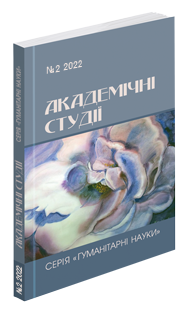Abstract
Romantic tendencies in the work of Honore de Balzac are marked by an appeal to various types of art: painting, sculpture and music. The French realist is interested in the issues of the essence of art, as well as the characteristics of the artist as a person who is genius and atypical and also who needs the understanding and participation of others. In the center of the novel «Sarrazin» is the figure of genius who strives for improvement and is in search of an ideal. However, the perfect image of human beauty becomes destructive both for the protagonist’s artwork and for his life. Love for the opera singer Zambinella, who turns out to be a young man, becomes fatal for the sculptor. If at first love inspires the young artist, then later it becomes incompatible with the love of art and even the life of the hero. The issue of art reception is singled out using the example of Sarrazin’s perception of vocal performance. Painter and sculptor is especially sensitive to the perception of music. Musical art transports Sarrazin to another world and his performer is etched in the hero’s memory forever. Attention is payed to the romantic symbolism of colors present in the text. Comparisons of the presentation of the artistic world in the author’s other novels «Gambara» and «Massimilla Doni» are traced. In the novels, there are romantic motifs through the prism of the presentation of music and the image of the artist. Emphasis is placed on the differences in the positions of Sarrazin and Gambara regarding the combination of different types of love: love of art and love for a woman. In addition, the artistic markers in the novels are highlights and their context is detailed in comparison with the mention of the names of composers and artists and artists and their works in H. de Balzac’s novel «Massimilla Doni» It is concluded that the artistic integrity of Balzac’s «Sarrazin» in combination with the presentation of art in the novels «Gambara» and «Massimilla Doni» indicate the realization of romantic motives in the artistic work of the French realist and complement the contemporary vision and understanding of art and its role in the life of society in general and of an individual in particular.
References
Сипа Л., Ковальчук О. Музичний дискурс у новелі Оноре де Бальзака «Массімілла Доні». Науковий вісник Міжнародного гуманітарного університету. Серія : Філологія, 2019. Вип. 42. Т. 2. С. 49–52.
Сипа Л. М. Романтична постать митця в повісті Оноре де Бальзака «Ґамбара». Вчені записки Таврійського національного університету імені В. І. Вернадського. Серія : Філологія, 2020. Т. 31 (70). № 1. 77–80.
Balzac H. Gambarra. BeQ. 131 p. URL : https://beq.ebooksgratuits.com/balzac/Balzac-73.pdf
Balzac H. De Massimilla Doni. BeQ. 169 p. URL : https://beq.ebooksgratuits.com/balzac/Balzac-72.pdf
Balzac H. de. Sarrasin. BeQ. 76 p. URL: https://beq.ebooksgratuits.com/balzac/Balzac-43.pdf
Balzac et la peinture. Tours, 2004. 287 p.
Borowitz H. O. Balzac’s Sarrasine: the sculptor as Narcissus. Nineteenth-Century French Studies. 1977. Vol. 5, № 3/4. P. 171–185.
Chambers R. Sarrasine and the impact of art. French Forum. Pensylvania, 1980. Vol. 5, No. 3. P. 218 – 238.
Heathcote O. Sarrasine’ and Balzac criticism. Paragraph, 1983. Vol. 1. P. 18 – 28.
Kolb K. The Tenor of Sarrasine. PMLA, 2005. Vol. 120, No. 5 (Oct., 2005), P. 1560–1575. DOI:10.1632/003081205X73399
Petrey, S. Castration, Speech Acts, and the Realist Difference: S/Z versus Sarrasine. Realism and Revolution: Balzac, Stendhal, Zola and the Performances of History. Ithaca, NY, 2018. P. 53–82.
Savada H. Balzac au croisement des arts. Peinture, opéra et danse. L’année balzacienne. 2011. № 12. P. 125–144. URL : https://www.cairn.info/revue-l-annee-balzacienne-2011-1-page-125.htm DOI 10.3917/balz.012.0125
Sprenger S. Sarrasine de Balzac ou l’archéologie du moi moderne. La Plume et la pierre : l'écrivain et le modèle archéologique au XIXe siècle. Nîmes, 2007. P. 291–318.

